Thank you for being a digital volunteer! It’s very important that this work is performed in a standardized manner, so please make the effort to read and follow these instructions.
Our Transcription and Review Process
The STRI Pollen Cards Project
General Section
Collector Details Section
Taxonomy & Locality Section
Notes & Additional Info Section
Vea aquí para instrucciones en español
Our Transcription and Review Process

We seek to balance quality and speed with our transcription process - which of course is still evolving as we continue to develop this service. At the moment, this is how our system works:
1) Anyone can start transcribing or add to a transcription of a document.
2) Once a volunteer decides they’ve “finished” and they’re ready for review, a different volunteer (who must have an account on the site) can review the transcription and either send it back for edits, or complete the transcription.
3) The finished transcript is sent to the Smithsonian, where it may be used immediately, or undergo additional work.
The Smithsonian Tropical Research Institute Pollen Cards Project
The Smithsonian Tropical Research Institute - Center for Tropical Paleoecology and Archaeology invites you to help transcribe specimen cards for the Alan Graham pollen collection.
Dr. Graham collected pollen grains to build this catalog. Each of these cards corresponds to a pollen grain on a microscope slide. The data on the cards are invaluable to researchers. Sometimes Dr. Graham exchanged samples with institutions, sometimes collectors; other times, he edited information on the cards. Other researchers have also added information to the cards. You will see examples and guidance for transcribing these nuances below. We thank you for your help in transcribing these important cards.
Watch this video with Dr. Carlos Jaramillo to see the pollen collection and the cards in their catalog at STRI, as well as to learn more about the challenge of transcribing the STRI Pollen Cards:
Navigating the STRI Pollen Cards Project Page
This project features transcription fields spread across three tabbed sections. To navigate the STRI Pollen Cards Project transcription page, please use the blue tabs near the top of the main transcription box. These tabs have labels: "General" - "Collector Details" - "Taxonomy & Locality".
Be sure to save frequently. Type in all the information you can for the fields in each section before you click the orange [Complete and Mark for Review] button.
GENERAL
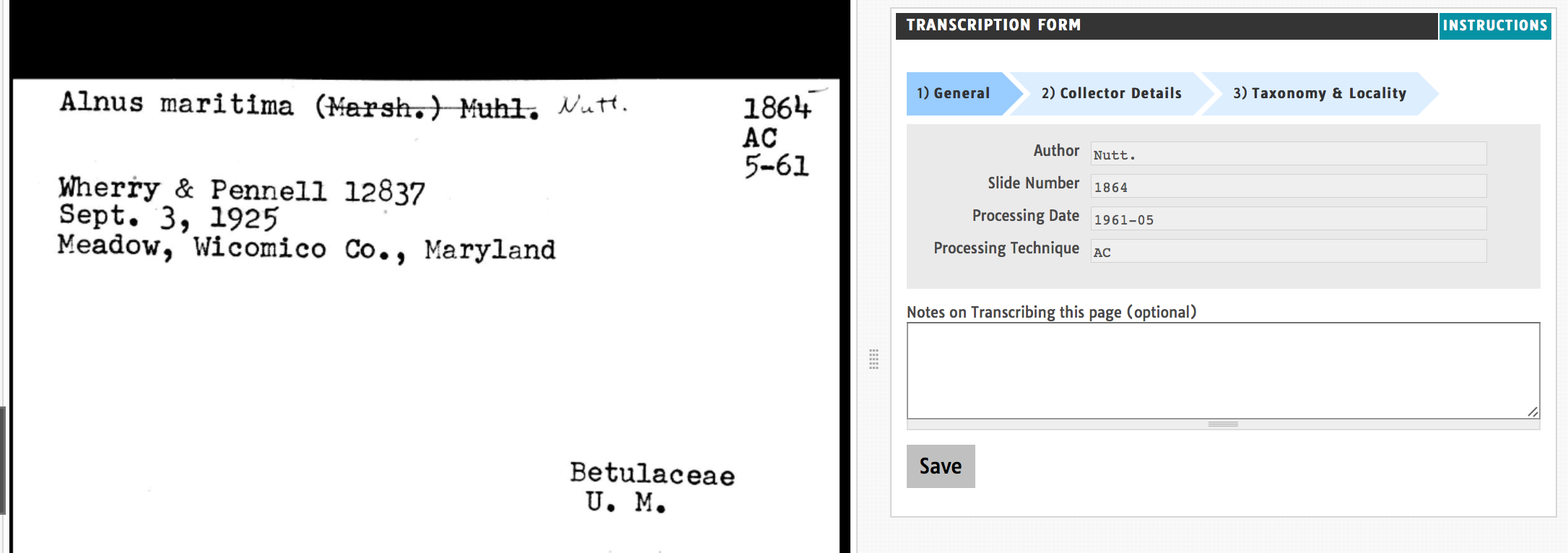
Author
In this field, you will enter the name of the person who described the species, referred to as the author.
The information may be included at the tail end of Genus and Species.
If abbreviated, please transcribe as written. For example, "Nutt." would be transcribed as "Nutt."
Sometimes this information has been edited, as in this example. Please transcibribe the handwritten Author. If necessary, leave a comment in the Notes on Transcribing This Page Field.
Slide Number
The slide number is very important as the key reference point to match pollen grains and these cards. This three to six digit number represents the slide in the Collection. Transcribe verbatim. In the example above, it is 1864.
Please do not transcribe commas in numbers. "10,243" should be transcribed as 10243.
Processing Date
In this field, you will enter the date that the pollen sample was prepared. Please transcribe the date using YYYY-MM or YYYY-MM-DD notation.
The date information and the format may vary on the card; it may be as little as "5-61" or “1961” or “May 1861.” In this example, "5-61" should be transcribed as 1961-05.
If missing, please leave blank.
Processing Technique
The technique used to process the anther that contained the pollen. Transcribe the entry verbatim. In the above card, it is "AC". See this card for an example of "Acetolysis", while in this card the processing technique is "KO-AC Clear". If missing, leave blank.
COLLECTOR DETAILS
This tab includes the details of the Collector and Collection Date, as well as the Herbarium Abbreviation, Herbarium Name, and Herbarium Number. This information is generally located in the center section of the card. The Herbarium Abbreviation, however, is often located in the bottom right hand corner of the card.
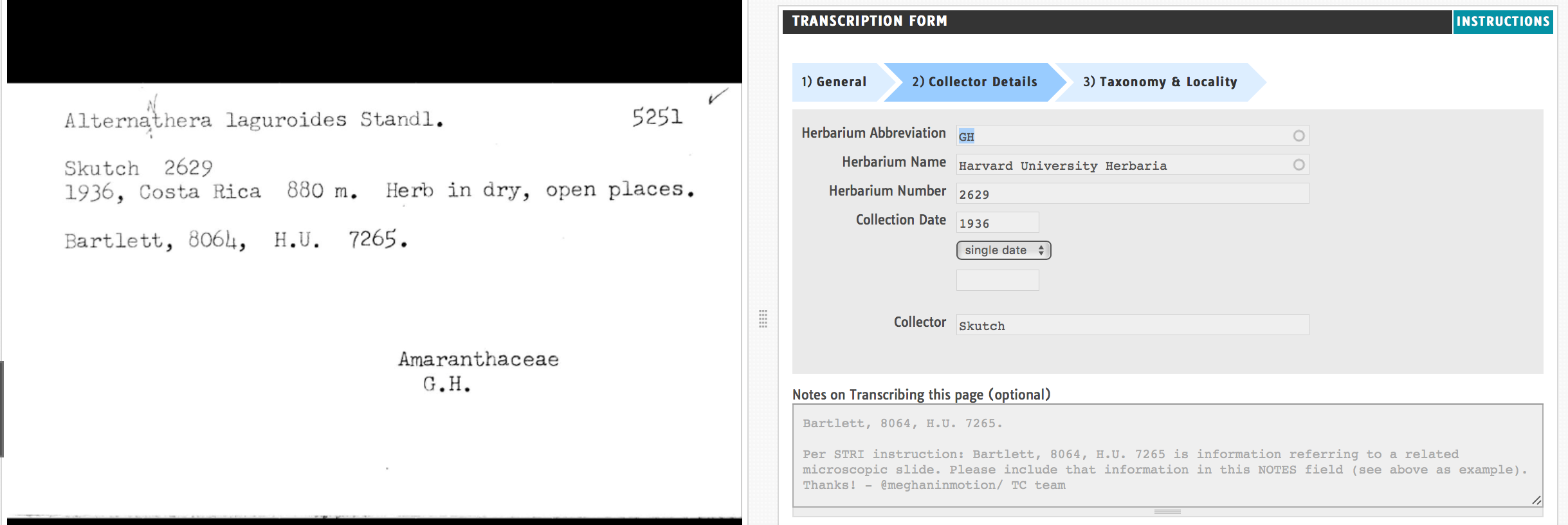
Herbarium Abbreviation
The abbreviation for the herbarium from which the pollen was collected. The abbreviation corresponds to the Herbarium Name. Entering the abbreviation will generate the Herbarium name as an automatic entry. You can use this Herbaria abbreviations list to assist you; it includes Herbaria with multiple abbreviations. Notes: Please do not include periods in your entry. "USNH" will be entered as US. If missing, leave blank.
If Herbarium Abbreviation is not listed in the autocomplete menu, you may also use this tool to search by the Herbarium Code; STRI researchers use this tool, as well.
Herbarium Name
The name of the herbarium from which the pollen was collected. The name corresponds to the Herbarium Abbreviation. Entering the abbreviation in the previous "Herbarium Abbreviation" field will generate the Herbarium name as an automatic entry. If missing, leave blank.
Herbarium Number
The "Herbarium Number" is the number for the pollen grain at the herbarium from which it was collected. This is often the number beside the collector name.
If not present, please write "NA".
If the number is preceded by something like "Chapman Herb. 3214", please transcribe Chapman Herb. 3214 in the Herbarium Number field.
Collection Date
This is the date the specimen was collected. This information, if present, will most likely be written on the line of text beneath the Collector name.
Please transcribe the date using YYYY-MM-DD notation. The date may be as little as “YYYY” (ex. "1936").
If a range, please indicate earlier date in first field and latter date in second field. If missing, leave blank.
Collector(s)
These are the people involved in collecting the plant and pollen grains. Please write them in using a LAST NAME, FIRST NAME format. In the example above, the collector would be "Skutch". For more than one collector, click the “Add collector” link to add another text field to enter additional collectors.
If missing, write “collector unknown”.
Note: if a card reads only "Harvard" in the center portion of the card, Harvard will be the collector.
When cards reference an exchange only, like Jarzen Exchange or Barbara Leyden Exchange, there is no Collector. You would enter "Collector Unknown". See below for details of exchanges. Please enter this exchange information in the Notes on Transcribing this Page field.
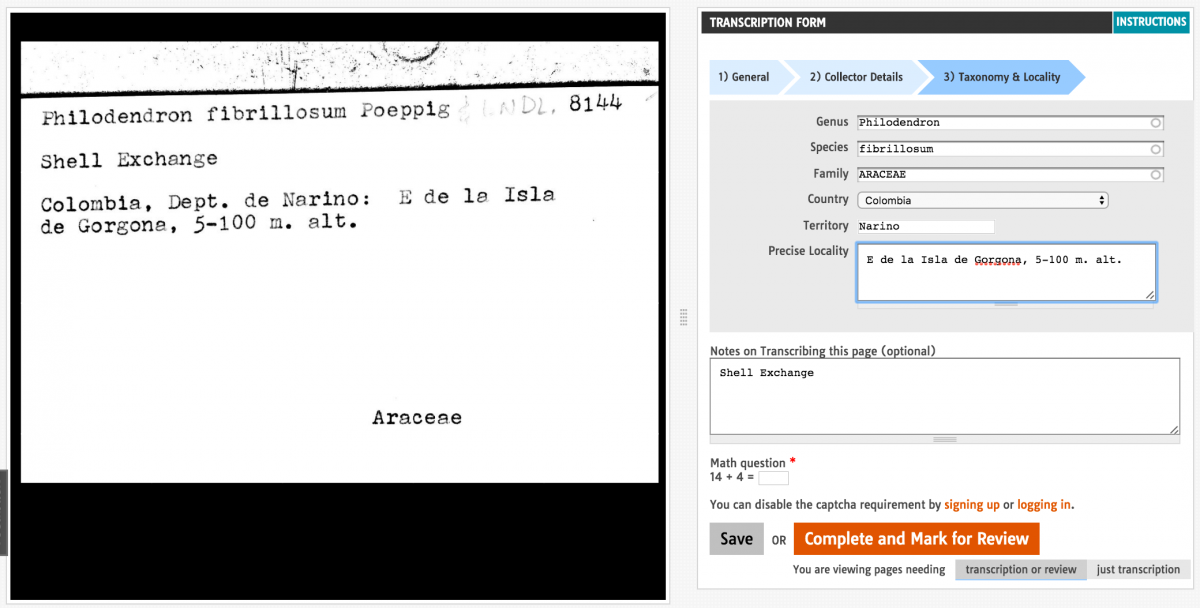
Exchanges
Occasionally on the cards, you will see Exchanges listed. The STRI team asks that you please enter information describing an exchange in the Notes on Transcribing This Page field. For example, "Denver Exchange" should be entered as Denver Exchange.
Additional Information to be entered in the "Notes on Transcribing this Page" field
Related Slides
Sometimes cards will include additional information below the Collector and Herbarium Number. One common example will be "Bartlett, 8064, H.U. ####." This information corresponds to other slides in the collection. It should be included in the Notes on Transcribing this Page field. This card is an example.
Handwritten Information
Please include any handwritten information or notes in the Notes on Transcribing this Page field.
TAXONOMY & LOCALITY
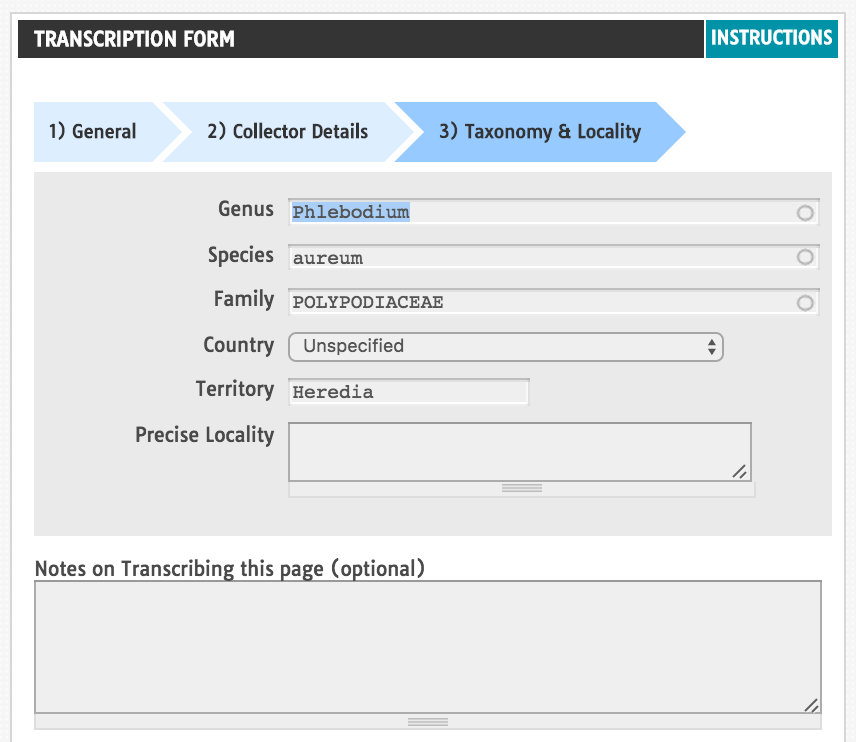
This tab includes information about the taxonomy of the pollen grain: Genus, Species, and Family. It also includes the locality information of Country and Territory, as well as any Precise Locality information.
Taxonomy is the arrangement of biological organisms into groups based on shared characteristics, then naming these groups; this is the classification of biological organisms. Taxonomic ranks include Domain - Kingdom - Phylum - Class, Order, Family, Genus, and Species. These ranks are arranged from most to least inclusive. As we transcribe, we will focus on the Genus and Species, as well as Family when present on the cards. On the STRI pollen cards, the upper line of the card will frequently display Genus and Species. In the example above, the Genus is Phlebodium and the Species is aureum. The Family is Polypodiaceae.
Genus
The Genus will be the first word in the taxonomic order at the top of the cards. Begin typing the Genus and the typeahead menu will help your entry. You may also continue typing to enter a name that is not in the list. You can also use a search engine to assist your entry.
Species
The Species will be the second word in the taxonomic order at the top of the cards. Begin typing the Species and the typeahead menu will help your entry. You may also continue typing to enter a name that is not in the list. You can also use a search engine to assist your entry.
Sometimes variant information is included on the card. This information can be transcribed in the Notes on Transcribing this page field.
Family
The Family will be located at the bottom right hand of the cards. Begin typing the Family and the typeahead menu will help your entry. You may also continue typing to enter a name that is not in the list. You can also use a search engine to assist your entry.
If two Family names are provided, please enter the first Family via the typeahead menu. Then transcribe the second Family in the Notes on Transcribing this page field.
Some Family names have been subsumed under more current Family names. Examples include:
If not present on the card, leave blank.
Country
The country where the pollen was collected or cultivated. Use currently accepted name for the country. In this example, the country is Costa Rica. If missing, leave blank.
State / Territory
The second level of geographic division inside country where the pollen was collected or cultivated. Use currently accepted name for the State / Territory. In this example, the territory is Heredia. To find this information, you might use Geonames.org. If missing, leave blank.
Precise Locality
Any information about where the plant was collected that goes beyond country. This information is often featured in the center portion of the cards. For example, if the card reads "Europe," please enter Europe in this field.
Please transcribe the locality verbatim. If unsure of the spelling of a locality, please add [sp.?] to the locality.
If there is an alternate or corrected spelling, please add this in brackets to the locality.
If missing, leave blank.
Using Geonames
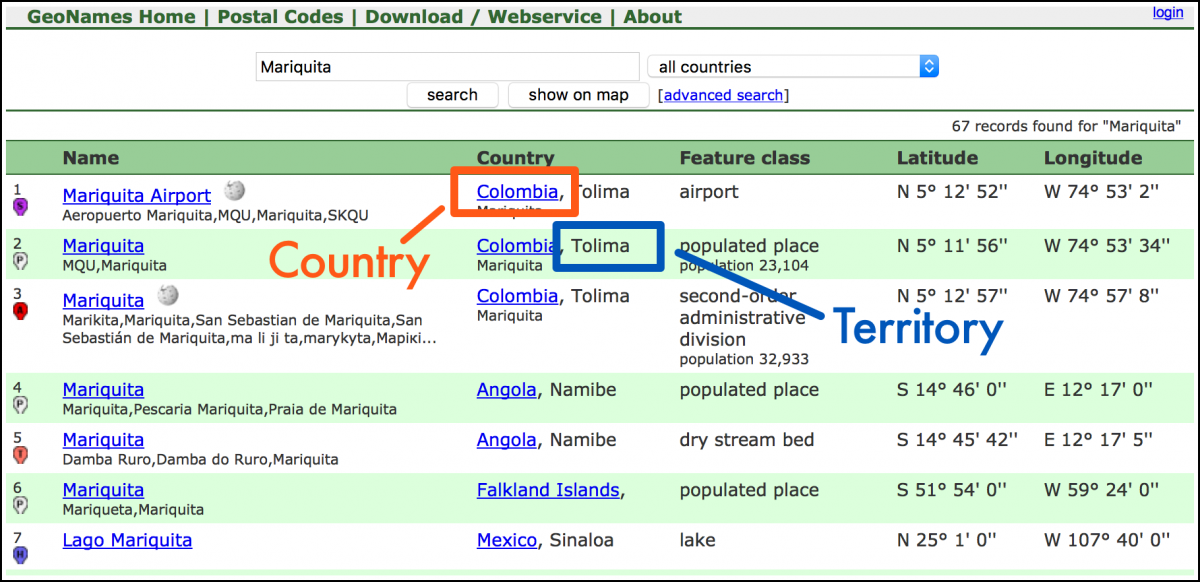
Understanding where a plant was collected (or cultivated) is very important for conservation and distribution research. Scientists use this information to determine the rarity of the plant species, and where the plant can be found in the world. A tool you can use to clarify locations is http://www.geonames.org/, which can help you determine the current state/territory place name that plant was collected in. You can also use a search engine like Google to confirm locations - this is something scientists and botanists do as well.
Notes Section & Additional Information
Notes on Transcribing This Page
Generally, the notes section is for communicating any questions or concerns to Smithsonian staff, as well as other volunteers, about this transcription.
However, the STRI team asks that you please include information about Exchanges in this field.
Other examples of use for this field: For instance, if you aren't sure about the precise locality, but you made your best guess, you can indicate that here. Or if you are a reviewer and wanted to make a comment to staff or other transcribers, you can use this field. Final example - if you find that typed material and handwritten text conflict with one another, make a judgement call and then include details of your decision in this field.

